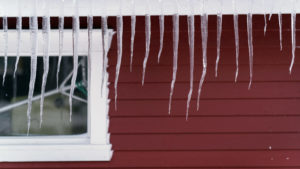
Icicles on the house can be a sign that snow is melting and refreezing, creating the conditions that can cause an ice dam.
One winter headache a homeowner doesn’t need – and can take steps to avoid – is an ice dam on the roof. Ice dams can damage walls and ceilings and possibly trap moisture, which could lead to mold, mildew and respiratory problems.
An ice dam is created when heat rises from a home, melting snow on the roof. The snowmelt forms layers of ice that accumulate on the edges of the roof, causing water to back up and form pools. The water in the pools leak through your roofing material, damaging the interior of your home.
CAUSE AND EFFECT
- Ice dams form in cold weather when there is a layer of snow on the roof
- Heat within the house rises into the attic, warming the roof
- Snow on the roof melts, causing water to run under the snow down to the roof edge
- At the lower edge, the water refreezes under the snow and forms a thin layer of ice
- As the process repeats, the layer of ice increases in size, holding back a pool of water on the roof
- This process can force water under the roof covering
- From there, the water can find its way into the attic or down the walls of the home
More information: University of Minnesota Extension, Dealing with and preventing ice dams
PREVENTION STEPS
Follow these tips to help prevent water damage from an ice dam:
- Clean all leaves, sticks and other debris from your home’s gutters and downspouts to clear a path for melting snow. Keep downspouts clear of snow and icicles
- Evaluate the insulation and ventilation in your attic. Most experts recommend at least R-30 insulation value for an attic (R-38 preferred in northern climates)
- Remove or relocate heat sources installed in open attic areas directly under the roof
- Insulate light fixtures in the ceiling below an unheated attic space
- Insulate and seal attic penetrations such as vents
- Consider installing an ice melt cabling system on your roof
This loss control information is advisory only. The authors assume no responsibility for management or control of loss control activities. Not all exposures are identified in this article. Contact your local, independent insurance agent for coverage advice and policy service.
